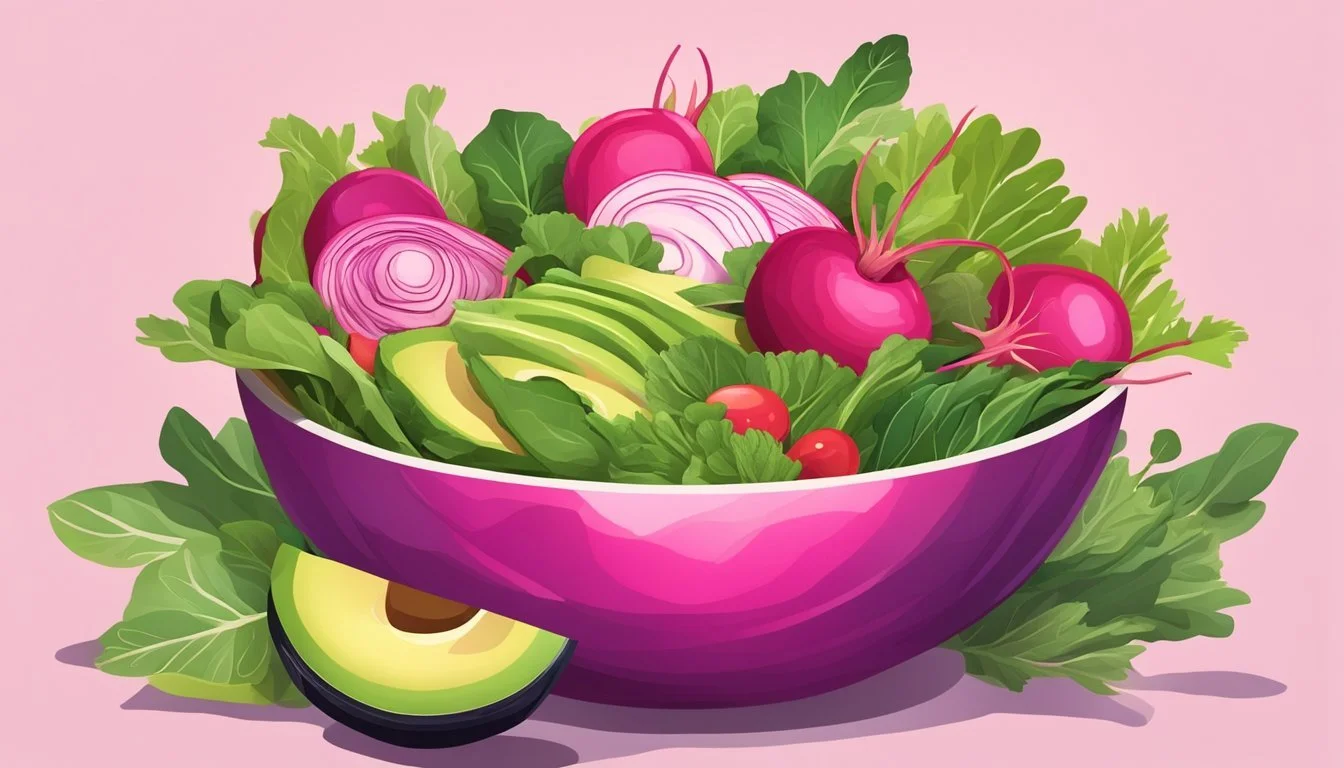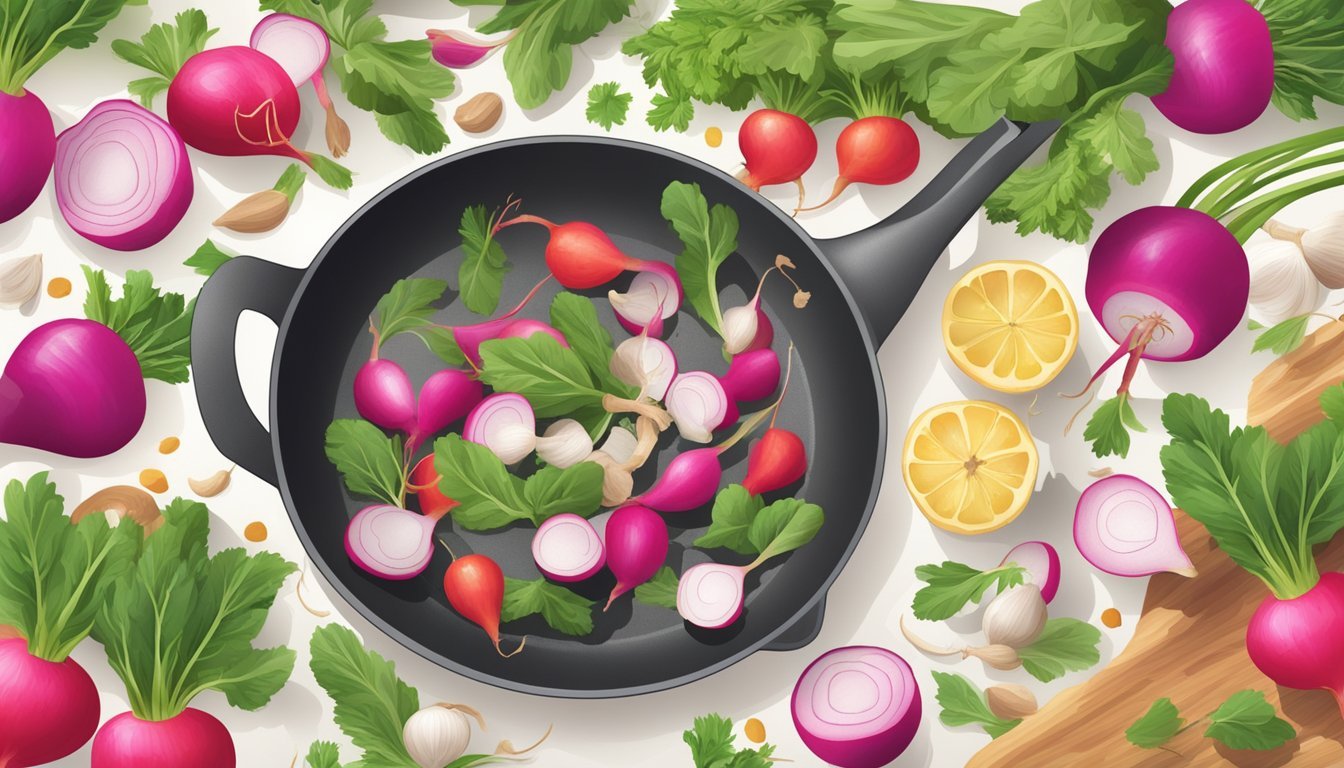5 Delicious Ways to Enjoy Radishes as a Diabetic
Healthy and Flavorful Options
For individuals managing diabetes, finding tasty and nutritious food options is essential. Radishes are an excellent choice because they are low in calories and carbohydrates yet high in fiber and essential nutrients. These attributes make radishes a valuable addition to a diabetic-friendly diet.
Exploring new and delicious ways to prepare radishes can help maintain variety and enjoyment in meals. This article presents five creative methods to incorporate radishes into a balanced diet without compromising flavor or health.
1) Radish Hummus
Radish hummus offers a unique twist on a classic dip, making it a delightful and healthy option for diabetics.
Start by blending cooked chickpeas, tahini, lemon juice, and garlic in a food processor. Add a handful of fresh radishes, sliced thin, to the mix. Their peppery flavor pairs beautifully with the creamy base.
The radishes enhance the hummus with a crunchy texture and vibrant color. They also contribute essential nutrients like vitamin C and potassium, which are beneficial for overall health.
Radish hummus not only tastes great but also provides a low-carb snack option. Serve it with fresh vegetable sticks or whole grain crackers for a satisfying and nutritious snack.
This radish hummus can be stored in the refrigerator for up to a week, making it easy to enjoy anytime.
2) Roasted Radish and Avocado Salad
Roasting radishes brings out their natural sweetness and creates a delightful contrast with the creaminess of avocado.
Start by preheating the oven to 425°F (220°C). Cut the radishes in halves and toss them with a bit of olive oil, salt, and pepper. Spread them on a baking sheet and roast for about 15-20 minutes until they are tender and slightly caramelized.
While the radishes are roasting, prepare the avocado. Slice the avocado into cubes or thin slices. In a small bowl, whisk together a dressing with olive oil, lemon juice, salt, and a pinch of garlic powder.
Once the radishes are done, let them cool slightly. In a large bowl, combine the roasted radishes, avocado, and mixed greens. Pour the dressing over the salad and toss gently to coat.
This Roasted Radish and Avocado Salad combines the best of both worlds. The sweetness of the roasted radishes pairs perfectly with the creamy avocado, making it a delicious and satisfying dish for diabetics and others looking to enjoy a nutritious salad.
3) Radish and Cucumber Yogurt Dip
Radish and cucumber yogurt dip is a refreshing and healthy choice for diabetics. It combines the crunchiness of radishes and cucumbers with the smoothness of yogurt, creating a tasty and nutritious dish.
Start by grating a few radishes and slicing cucumbers into thin rounds. Mince some fresh herbs like mint or cilantro for added flavor.
In a mixing bowl, whisk together chilled yogurt until smooth. Add the grated radishes, cucumber slices, and minced herbs to the yogurt. Season with salt, pepper, and a pinch of roasted cumin powder.
Mix everything well to ensure that the vegetables are evenly coated with the yogurt. This dip is not only delicious but also helps in managing blood sugar levels due to its low glycemic ingredients.
Serve the dip cold, garnished with a sprinkle of chat masala or fresh herbs. It's perfect for dipping with raw vegetables or whole-grain crackers. This simple yet flavorful dip can be a great addition to any diabetic-friendly diet.
4) Radish Stir-Fry
Radish stir-fry offers a quick and nutritious way to incorporate radishes into a diabetic-friendly diet. Start by washing and trimming the radishes. Slice them thinly for even cooking.
Heat a small amount of oil in a pan or wok over medium-high heat. Add the radish slices and stir-fry them for 5-7 minutes until they are just tender but still slightly crisp.
Enhance the flavors by adding garlic, ginger, or your favorite stir-fry seasonings. Radishes pair well with soy sauce, sesame oil, and a touch of chili for some heat.
Consider adding radish greens to the stir-fry. They cook quickly and add a nutritious boost. Serve the stir-fried radishes warm alongside your main dish.
This method retains the radishes' natural crunch and slightly peppery flavor. The quick cooking time ensures that the radishes do not lose their beneficial nutrients, making it an excellent option for those managing their blood sugar levels.
5) Pickled Radish Slices
Pickled radish slices offer a tangy and crunchy addition to meals, perfect for those managing diabetes.
To prepare, thinly slice radishes either using a mandoline slicer or a knife. The goal is to achieve a uniform thickness for even pickling.
In a saucepan, combine vinegar, water, sugar, and salt. Heat and stir until the sugar and salt dissolve. Allow this brine to cool to room temperature.
Place the radish slices in a jar and pour the cooled brine over them. Seal the jar and refrigerate. The radish slices can be enjoyed after just an hour or left to pickle for a deeper flavor over several days.
These pickled radish slices add zest to salads, sandwiches, and tacos. They are a delightful, low-calorie option that can enhance the flavor balance in various dishes.
Experimenting with spices like peppercorns or mustard seeds in the brine can add an extra layer of complexity to the pickles. The process is simple, making it easy to incorporate this healthy snack into a diabetic-friendly diet.
The pickled radish slices can be stored for up to three weeks in the refrigerator, providing a convenient, tasty option whenever needed.
Nutritional Benefits of Radishes
Radishes are particularly beneficial for diabetics due to their low glycemic index and high fiber content. These characteristics help manage blood sugar levels and support digestive health.
Low Glycemic Index
Radishes have a low glycemic index (GI) of just 15, making them an excellent choice for diabetics who need to keep their blood sugar levels stable. Foods with a low GI release glucose slowly into the bloodstream, preventing sudden spikes. Including radishes in meals helps maintain balanced blood sugar levels, reducing the risk of hyperglycemia.
Radishes also contain antioxidants like vitamin C, which help reduce oxidative stress. High levels of oxidative stress can lead to cell damage, a concern for those with diabetes. Therefore, radishes' low glycemic impact combined with their antioxidant properties makes them a valuable addition to a diabetic diet.
Rich in Fiber
Radishes are an excellent source of dietary fiber, providing about 1 gram per half cup. Consuming fiber-rich foods is particularly beneficial for diabetics because fiber slows down the absorption of sugar into the blood. This helps to avoid rapid spikes in blood sugar levels.
Fiber also promotes a feeling of fullness, aiding in weight management, which is important for those managing diabetes. The fiber in radishes contributes to healthy digestion by adding bulk to fecal matter and facilitating its movement through the intestines. This can help prevent constipation and support overall gut health, making radishes a dual-benefit food for diabetics both in terms of blood sugar and digestion.
Managing Blood Sugar Levels with Radishes
Radishes have specific properties that can help manage blood sugar levels. They can positively impact insulin sensitivity and are a beneficial addition to a diabetic-friendly diet.
Impact on Insulin Sensitivity
Radishes contain compounds that can help improve insulin sensitivity. They are rich in fiber, which slows carbohydrate absorption and helps stabilize blood sugar levels.
These vegetables also provide antioxidants, such as vitamin C, which protect cells from damage caused by high blood sugar. Moreover, their low carbohydrate content reduces the risk of blood sugar spikes after meals.
Including radishes regularly can aid in managing diabetes by enhancing the body’s use of insulin, leading to better controlled blood sugar levels.
Inclusion in a Diabetic-Friendly Diet
Radishes are a versatile and low-calorie addition to a diabetic diet. They have only about 19 calories per cup and are high in fiber, which helps in feeling full and satisfied.
Their crunchy texture and peppery flavor make them an excellent snack or salad ingredient. Radishes can be consumed raw, roasted, or pickled, providing variety in meal planning.
To maximize their benefits, pair radishes with other low-carb vegetables and proteins. Incorporating them into meals helps maintain balanced blood sugar levels, supporting diabetes management.
Lists and nutritional tables for tracking their impact can be very helpful.
Creative Ways to Incorporate Radishes in Meals
Radishes offer a versatile, low-carb ingredient that adds crunch and a peppery flavor to meals. Here are some specific ways to incorporate radishes into different types of dishes.
Salads and Raw Dishes
Radishes shine in salads and other raw dishes due to their crisp texture. They pair well with ingredients like carrots, avocado, and quinoa. For a refreshing touch, try a Spring Carrot, Radish, and Quinoa Salad with a lemon vinaigrette.
Alternatively, sliced radishes dipped in olive oil and herbed salt make for a crunchy, flavorful snack. Mix chives, parsley, tarragon, lemon zest, and garlic with salt for a simple yet tasty seasoning.
Stews and Soups
Radishes can be a surprising addition to stews and soups. When cooked, their flavor mellows, offering a subdued pepperiness that's ideal for hearty dishes. Include daikon radishes in a Korean kimchi stew for a traditional twist.
For a Western approach, chopped radishes can be added to vegetable stews. Roasting radishes before adding them to the stew enhances their flavor and provides a satisfying texture.
Fermented Radishes
Fermentation is a popular method to enjoy radishes, especially in dishes like Korean kimchi. Fermented radishes retain their nutrients and gain additional probiotics, which are beneficial for gut health.
To make fermented radishes, slice them finely and soak in a mixture of water, salt, and seasonings such as garlic and chili flakes. Let them ferment for a few days at room temperature before storing them in the fridge. This process adds complex flavors and keeps the radishes crunchy.
These methods highlight the versatility of radishes and their suitability for a diabetic-friendly diet.








